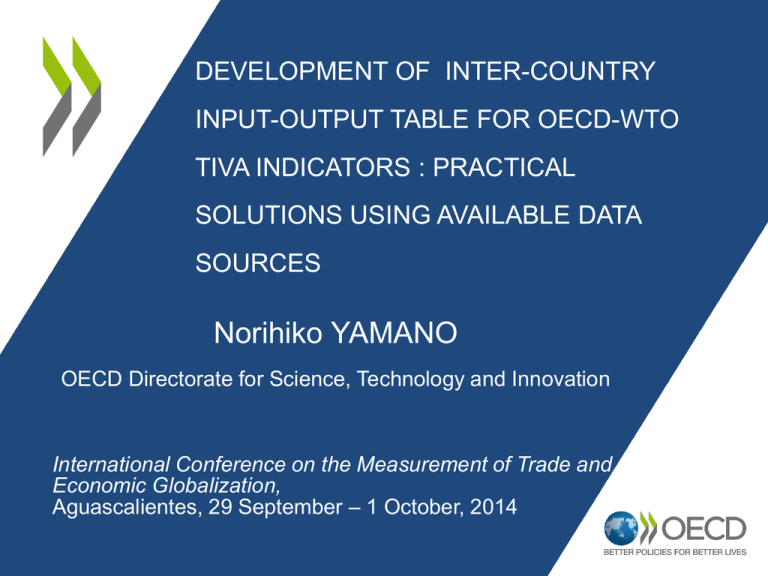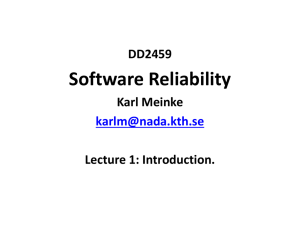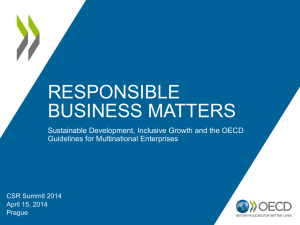Data sources
advertisement

DEVELOPMENT OF INTER-COUNTRY INPUT-OUTPUT TABLE FOR OECD-WTO TIVA INDICATORS : PRACTICAL SOLUTIONS USING AVAILABLE DATA SOURCES Norihiko YAMANO OECD Directorate for Science, Technology and Innovation International Conference on the Measurement of Trade and Economic Globalization, Aguascalientes, 29 September – 1 October, 2014 Outline 1. ICIO database, a core model for TiVA 2. Specification of ICIO database required for TiVA indicators 3. Ideal statistics to build ICIO 4. Reasons of asymmetries and unharmonised reported statistics 5. Methodology 6. Wishlist (short-term) 2 ICIO and policy applications Core of the TiVA database is an economic model based on Inter-Country Input-Output table (ICIO). ICIO models allow us to analyse • Trade in Value-added & Global Value-Chains • Foreign contents in consumption and exports • Jobs sustained by foreign demand • Carbon emissions embodied in trade 3 What does ICIO look like? November 2014 release • 34 Industry (ISIC rev3) • 61 countries and regional average e.g. 34 OECD, BRIICS, G20, EU28, NAFTA, ASEAN*, APEC*) • Year: 1995,2000,05,08,09,10, 2011* • Format: industry-by-industry, basic price 4 Development flow • Collection of national data sources • Harmonisation and filling gaps – – – – National Accounts main components Sectoral constraints of value-added and output National I-O and Use tables Bilateral trade in goods and services • Numerical adjustment for solving asymmetries in bilateral trade coefficients • Global use table and ICIO • Indicator calculations & Dissemination 5 Our approach • Official published I-O/SUT, National Accounts and Trade databases used for – Institutional long-term – Recognized starting point • Benchmarked to National Accounts (final expenditures, value-added, output, definitions of exports and imports) • Benchmarked to Balance of Payment trade balances • Rest of the world (closed model) 6 1) Ideal I-O/SUT to build an ICIO • Both in purchasers’ prices and basic price • Domestic and import tables • Enough sectoral details to aggregate to harmonised sector classification • Compatible with BoP / SNA (at least definitions) 7 ‘Output and Value-added’ • Output = Intermediate inputs + imports + taxes less subsidies + Value added components ‘Trade’ • Exports = Expenditure by non-resident in domestic and foreign territories • Imports = Expenditure by residents in domestic and foreign territories • Household consumption (by residents) • Capital formation • Recycling source appears in inventory adjustment 8 OECD National Input-Output database Domestic table 9 2) Ideal trade statistics to build an ICIO For combining with national SUTs or IOTs: best estimates of bilateral trade in goods and services by industry (product group) and by end-use (intermediate and final consumption) … – Bilaterally consistent (mirror trade) – cif/fob margin allocation to origin transport support activities – Reflect recent production activities – Complete (by product and partners) – Compatible with BoP / SNA (SUTs and IOTs) – Reexports and reimports by origin & destination 10 Data sources for OECD Inter-country inter-industry model Data sources Supply-use and Input-Output tables (National sources/ Eurostat / Asian Dev Bank) Bilateral trade statistics for goods and services (OECD / UN) National Accounts: main aggregate and satellite (NSIs, OECD, UN) Balance of Payments (National source / IMF) Intermediate analytical data products at OECD Harmonised symmetric Input-Output tables (OECD I-O) Bilateral Trade Database by Industry and by End-use for goods (BTDIxE) Sectoral Value-Added (STAN) Harmonised Bilateral Trade in Services (OECD-WTO) Adjusted National Accounts (currency, discrepancy and re-exports) 11 General data issues • Harmonisation issues of SNA and National IO/SUT • Price valuation (producers’price / basic price/purchasers’price) • Relationship between imported goods and trade related services (cif/fob) • Non-resident expenditures (65-75 % svc) • Time series comparability (services) 12 Wide ranging activities to improve underlying statistics • CSSP: Expert Group on Extended Supply and Use Tables • Coordinate contributions from other international organisations including Eurostat, APEC, ADB, UN ECLAC and UN ESCWA • WPTGS: Reflection Group on more detailed services trade statistics, as well as active appeals for certain service category data (for CIF/FOB adjustments) • Analytical work on trade asymmetries as well as facilitation of bilateral meetings on asymmetries via WPTGS • WPTGS stocktaking questionnaire on activities at NSOs related to linked trade and business statistics (TEC, TEC+, STEC) • Analytical work on – CIF/FOB ratios for countries reporting imports on both CIF and FOB basis (few) – Comparing trade by industry data from SUTs, TEC and using conversion keys 13 Balancing issues: Bilateral trade Balancing issue : Bilateral trade matrix cou A Exporting country cou A Importing country cou B 15 SNA cou C 30 Total exports 45 40 5 15 30 30 20 cou B 10 cou C 20 10 Total imports 30 25 35 30 35 25 SNA constraints 90 90 14 Difference: reported imports – sum of key partners’ exports (2011) OECD BTDIXE 2013ed 15 Costa Rica Partners' Costa Rica reported imports reported exports from Costa Rica ratio Total 9045 26766 2.96 Close neighbours USA Mexico Canada Brazil Netherlands Belgium UK Germany Other Europe China Hong Kong Malaysia Singapore Japan Rest of World 2255 3385 254 95 40 634 312 160 139 373 269 438 169 42 85 396 2284 8944 1902 424 388 3047 468 330 476 830 3107 994 1286 555 345 1388 1.01 2.64 7.48 4.45 9.79 4.81 1.50 2.06 3.43 2.23 11.56 2.27 7.62 13.29 4.07 3.50 What is happening ? Not all due to multiple counting of re-exports? High transport costs, big mark-ups, transfer pricing by MNEs ? BTDIxE2013 17 Methodology After collection and filling gaps for 212 economies … • Classification conversion: reported HS, EBOPS, national industry classification • Estimation of bilateral trade flows in use table sector classification • Estimation of national IO and use tables reconciled with NA based figures • Balancing international trade flow using adjusted use table and bilateral partner shares 18 BTDIxE end-use categories • 3 SNA end-use categories – Intermediate inputs – Household consumption – Capital goods • 5 mixed end-uses – – – – – packed medicaments personal computers passenger cars phones (fixed and mobile) valuables + other n.e.c 19 Adjusting merchandise trade statistics to NA framework (goods exports) Merchandise trade (fob) SUT / IO / NA export Retained Retained by partner by partner re-export re-import goods Re-export Goods (in import matrix) non-resident trade margin Other services SVC 20 Beyond 6digit trade statistics: Used (second-hand) products Source:Eurostat 21 Adjusting bilateral trade in services • National accounts benchmarked • Reconciliation of exports and imports at EBOPS at 10 categ.(OECD-WTO) • Filling gaps (unavailable pairs, construction and renting equipment) • Converted to product dimension in SUT • Bilateral trade flows 22 Balancing procedure of Wang et al (2013), eds Mattoo, Wang & Wei • Stage 1: Reconciliation of sectoral exports and imports – Sum of total exports of goods and services of all countries matches total imports • Stage 2: Reconciliation of national SUTs using adjusted trade vectors and national accounts constraints • Stage 3: Linking national use table with bilateral trade coefficients 23 Balancing Inter-country Use table (ICUT) basic price Sector 1: Goods Country A Intermediate demand Country A Country B Sector 1 Sector 2 Sector 1 Sector 2 Z11AA Z12AA Z11AB Z12AB Z21AB TMZ1AB TMZ2AB CIF/FOB adjustment CFA11AB Z11BB Z21BB CFA12AB Z12BB Z22BB CFAF1AB F1BB F2BB Z12BA Z22BA TMZ2BA - CFA12BA NTZ2A V2A X2A Z22AB Country B F1AB Sector 2b: Services (trade/insurance) Sector 1: Goods Z11BA Sector 2a: Services Z21BA Country B Sector 2b: Services (trade/insurance) TMZ1BA CIF/FOB adjustment - CFA11BA Taxes less subsidies on products NTZ1A Value-added V1A Output at basic price (ind) X1A Z22AA Country A F1AA F2AB TMFAB Sector 2a: Services Z21AA Non-resident CIF/FOB Output expenditures adjustment (prd) Country A Country B FNR1AB X1A Final demand - F2AA F1BA F2BA BA FNR2AB - CFA + CFA NTZ2B V2B X2B - CFAF1BA NTFDA X2bA A FNR1BA FNR2BA X1B X2aB TMF NTZ1B V1B X1B X2aA A - CFA B X2bB +CFAB B NTFD B NTFN A NTFN 24 Wishlist (short-term) • Statistics that are timely and nationally consistent (across sources) • Statistics with appropriate detailed breakdowns (by country and industry/product category) which are internationally comparable • An international trade matrix that is perfectly symmetrical, complete (no missing values), consistent with data in IO/SUT/NA, and converted to end-use categories 25 Data sources Available Requirement Value added and Output SNA: Value-added By product and Output by Industry (all) Manuf. Census/SBS: detail sectoral info Final expenditure Purchasers’ prices Extended ICIO/SUT By HGT Basic price *HGT: Heterogeneity within industry e.g. exporter/non-exporter, firm size, Processing/domestic, foreign-owned, sub-national regions 26 Data sources Available Requirement Trade (national total) BOP (total goods and services) Conversion from EBOPS to product and industry dimensions Bilateral trade Export fob, pu prices Import cif, pu prices Service by EBOPS (6dgt – 10dgt) Trade partner shares by end-use category; International trade margin, fob and basic price based estimate Extended ICIO/SUT Import partner shares by HGT *HGT: Heterogeneity within industry e.g. exporter/non-exporter, firm size, Processing/domestic, foreign-owned, sub-national regions 27 Data sources Available Requirement Input-Output SIOT(p x p) Import matrices (p x p) Use table Use pu prices and pr prices Harmonisation with SNA Trade margin, taxless-subsidy on products, nonresident expenditures Supply Country total Supplying industry by supply by industry exported and domestically consumed products Extended ICIO/SUT Use at bp Import (p x i) Supply (product by exporter & nonexporter) 28 THANK YOU www.oecd.org/trade/valueadded 29







